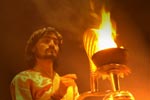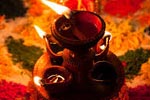As with any other ancient civilization, India is a land of deep-rooted customs. Customs are nurtured and nourished to maintain deeply held values. India is a multi-cultural combination of a mix of a myriad of peoples, religions, ethnic backgrounds all resulting in a multitude of customs.

Doing Namaste
Is a polite way of greeting each other in India; a cultural convention and an act of worship. This gesture is marked by placing both the palms together raised below the face to greet a person.
Tilak
It is a religious red or a white mark and invokes a feeling of sanctity. The Tilak is thus a blessing of the Lord and a protection against wrong tendencies and forces. The Tilak cover the spot between the eyebrows, which is the seat of memory and thinking.
Ringing Bell in the Temple
It produces an auspicious sound. It produces the sound Om the universal name of the lord. It also helps drown any inauspicious or irrelevant noises and comments that might disturb the worshipper in their devotional ardor. All rites and ceremonies of the Hindus begin with a Tilak topped with a few grains of rice placed on the forehead.

Aarti
Aarti is performed as an act of veneration and love. It is often performed as a mark of worship and to seek blessings from God, to welcome the guests, for children on their birthdays, family members on auspicious occasions or to welcome a newly wedded couple. The purpose of performing Aarti is to ward off evil effects and the malefic influence of the 'evil eye'.
Prostrating Before Parents and Elders
Indians prostrate before their parents, elders, teachers and noble souls by touching their feet. The elder in turn blesses us by placing his or her hand on or over our heads. Touching the feet in prostration is a sign of respect for the age, maturity, nobility and divinity that our elders personify.

Garlanding
Flower garlands are generally offered as a mark of respect and honor. They are offered to welcome the visitors or in honor to the Gods and Goddesses. The garlands are generally made with white jasmine and orange marigold flowers. They are weaved in thread tied in the end with a help of a knot.
Lightning the Lamp (Diya)
Indians use lamps for festivals, religious rituals and lightning homes. A small lamp, which is known as "Diya" is lit before the picture or idol of god. Along with the Diya, incense sticks are also lit. It is lit in the early hours of morning or evening or both. It is considered to bring good luck to the house and is also considered sacred.

